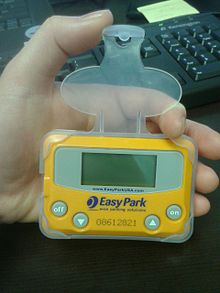In-vehicle parking meter

An in-vehicle parking meter (IVPM) (also known as in-vehicle personal meter, in-car parking meter, or personal parking meter) is a handheld electronic device, roughly the size of a pocket calculator, that drivers display in their car windows either as a parking permit or as proof of parking payment.
History
Implementation of IVPM began in the late 1980s in
Uses
Management
Parking managers who implement IVPM are able to combine all permit and pay-for-parking needs into one centralized system, which tracks data on where and for how long drivers are parking in specific locations. IVPMs can be customized based on a parking department's needs for what level of authority is parking, where they park, when they park, how long they park, and how much they are charged.[3]
Payment
Depending on the entity where IVPM is implemented, drivers either use their debit cards to load funds onto their IVPMs through their computers at home or parking offices distribute the IVPMs to drivers with preloaded permit restrictions. The IVPM only charges drivers for the amount of time they have the device turned on, as opposed to traditional meters that drivers put coins into and return with extra time leftover.

Enforcement
Parking enforcers see visually on each IVPM whether a driver has sufficient funds or is parked in a restricted zone. Each distributed IVPM has a
Sustainability
IVPMs typically have an 8-to-10-year lifespan and do not require the use of disposable paper receipts or plastic permits and decals that are associated with conventional parking management methods. Unlike traditional
References
- ^ Parking Today
- ^ a b Electronic iPark Devices Available Again | ARLnow.com
- ^ Shoup, Donald C. (2002). "Buying Time at the Curb" (PDF). University of California Transportation Center: 10–12. Retrieved 10 December 2012.
{{cite journal}}: Cite journal requires|journal=(help)[permanent dead link] - ^ Pay For Just The Parking You Use With This New Device | KUT News
